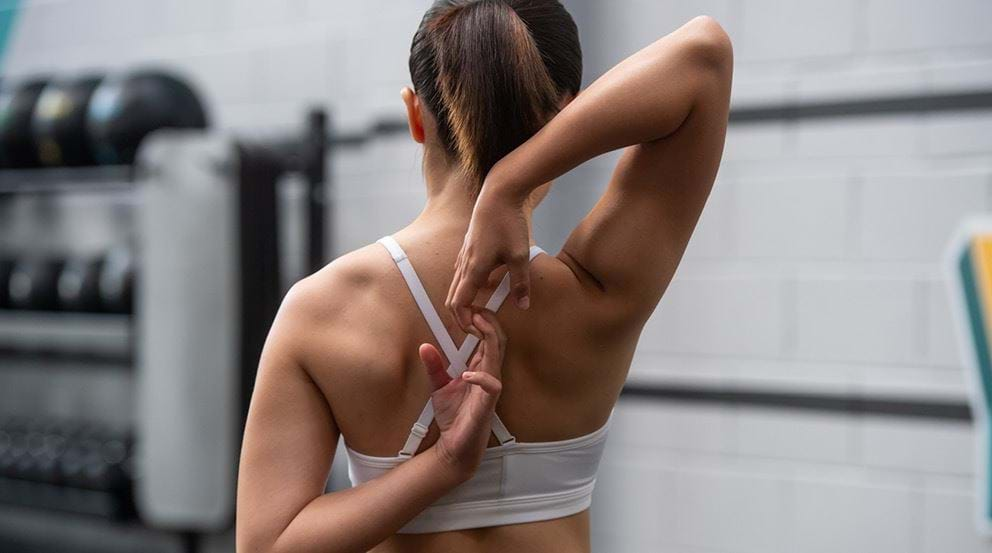6 of the Best Stretches for Tight Hamstrings

Struggling with tight hamstrings? You're not alone. Tight hamstrings are a really common issue as both activity and inactivity can lead to stiff, sore hamstrings -- which means no one is safe! Whether you are highly active, completely sedentary, or somewhere in between, if you're dealing with tight hamstrings, this article will help.
Although it sounds like one muscle, the hamstring is made up of three muscles, the Semitendinosus, Semimembranosus, and the Biceps Femoris which has both a short and long head. These three muscles sit at the back of your leg and are largely responsible for knee movements such as walking, running, and jumping. They also help to assist the glutes in any hip hinge movements, and they play a role in your posture too.
What does having a "tight" muscle actually mean?
When someone complains of having tight muscles, they are referring to a feeling of stiffness or pain which may prevent them from making certain movements. Tight muscles can be caused by several things, including:
Poor posture
Incorrect form and movement patterns
Overexercising and injuries
Delayed onset muscle soreness (DOMS)
Periods of prolonged inactivity
What causes tight hamstrings?
There are multiple factors that can lead to tight hamstrings, but typically these fall under: long periods of sitting, and overexercising.
Long periods of sitting down
Sitting down for extended periods can cause the hamstrings to feel tight. When we are sat down with our knees bent, our hamstring muscles are held in a shortened position. If you're sat down for hours every day, your hamstrings are constantly held in that shortened state which can cause tightness, stiffness and even a posterior pelvic tilt, which can lead to lower back and knee pain.
Changing positions throughout the day, including switching from sitting to standing, adding in dynamic stretches, and strengthening your hamstrings and glutes, will help combat tightness.
Overcompensating for weak muscles
Did you know that the term 'use it or lose it' is true when it comes to your muscles? If you find yourself sitting for extended periods, your glute muscles can become weaker and lazy. This means that when you do exercises that usually engage your glutes they won't activate as much as they should, leaving your surrounding muscles to pick up the slack. So, if you spend a lot of your day sat down your hamstring muscles will have to overcompensate. Weak hip flexors and calves can also lead to the hamstring needing to work harder when moving to compensate for these imbalances.
Stretching the hamstrings will help to relieve stiffness caused by muscle imbalances but you will also need to strengthen both the hamstrings (to increase endurance) and the surrounding muscles (to combat the imbalance) to fix this issue permanently.
Poor posture
Poor posture can also lead to an imbalance between the hamstrings and other muscles. Having an excessive anterior pelvic tilt (APT), a common posture where the pelvis is rotated forward, causes the hip flexors to shorten and the hamstrings to lengthen, resulting in overstretched and weak hamstrings.
One of the main causes of excessive anterior pelvic tilt is -- you guessed it -- excessive sitting throughout the day, causing tight hip flexors which pull your pelvis forward. Improving your posture, stretching your hip flexors, and strengthening your hamstrings and glutes can help to combat APT and the accompanying hamstring tightness.
Overexercising
Exercising too much, or increasing how much exercise you do too quickly, can lead to muscle delayed onset muscle soreness (DOMS), muscle tightness and in some cases injury. Your hamstring muscles are fundamental for many different types of exercise, such as running, cycling, lifting, and many other sports, so it's easily done if you don't properly plan in recovery time and rest days too.
Stretching, foam rolling and myofascial release can be great tools if your hamstring tightness is a result of delayed onset muscle soreness (DOMS) but if the tight feeling is a result of an exercise induced injury, you'll need to rest up and consider speaking to a physiotherapist.
How to fix tight hamstrings
Unfortunately, fixing tight hamstrings involves more than an occasional stretch now and then. Combining strengthening and stretching exercises for tight hamstrings and calves, glutes, and hip flexors, and reducing the time you spend sitting down, will help to combat the muscle imbalances and postural problems that lead to tight hamstrings.
If you typically struggle with exercise related stiffness, making sure you properly warm up and cool down, including stretches and foam rolling, can help to alleviate any tightness.
6 of the best stretches for tight hamstrings
While it's important not to rely exclusively on stretches to help with tight hamstrings, they certainly play their part in easing stiffness. You should look to include a mixture of dynamic and static stretches at least 2 to 3 times a week, although more dynamic stretches can be incorporated if you are otherwise sat down all day!
So, what are the best stretching exercises for tight hamstrings?
Hamstring scoops
This is a great dynamic stretch that can be used before a workout or simply during the day.
Start by standing with your feet hip width apart
Extend one foot out, allowing the knee to bend slightly
Bending at the hip, reach your arms towards your feet and then make a scooping motion towards the ceiling
Repeat on the other leg
Standing knee hug
This stretch targets your hamstrings, glutes, and hip muscles, making it a great all-rounder to include in your routine.
Stand hip width apart and slowly lift one leg upwards before grabbing and hugging your knee towards your chest
Hold for as long as the stretch feels comfortable before returning your leg to the floor
Repeat on both sides 3-4 times
Watch how to do hamstring scoops and standing knee hugs in our Stretches for Runners warm up:
Seated hamstring stretch
This simple, static stretch is one of the best stretching exercises for tight hamstrings to do after a workout.
Start by sitting on the floor with your legs straight out in front of you
Keep your legs straight, and hinge at your hips and bend forward from the waist as far as you can go
If your hamstrings are particularly tight and that feels uncomfortable, instead bring one of your feet to your inner thigh and focus on stretching one hamstring at a time
Hold the stretch for 15-20 seconds
Lying hamstring stretch
Lie flat on your back with your feet planted on the floor
Lift your right leg up, keeping your leg as straight as possible while pointing your toe to the ceiling
Hold the back of your right thigh and gently pull your right leg towards the chest
Hold the stretch for 10 – 30 seconds and then repeat on the other side
Standing hamstring stretch
Start by standing with a neutral spine and gaze forward
Place your right leg in front of you, pointing your toes up to the ceiling
Bend your left knee slightly and then hinge at your hip, leaning forward to feel the stretch in your right hamstring
Keep your back neutral and avoid hunching - use your hands as support by gently placing them on your bent left knee
Hold this stretch for 10 – 30 seconds and then repeat on the other side
Standing forward fold hamstring stretch
Commonly found in yoga classes, the standing forward fold hamstring stretch works all the muscles in your posterior chain, making it great for those who sit down all day.
Start by standing up straight with soft knees
Hinge at the hips and Fold downwards, keeping your legs straight
Depending on your flexibility, you may not be able to touch your toes – if this is the case, go as far down as you comfortably can and hold for 20 – 30 seconds
Best exercises for tight hamstrings
While stretching can help relieve the pain caused by tight hamstrings, it won't prevent further stiffness. Strengthening your hamstrings, glutes, quads, calves, and hip flexors will promote muscular balance in your lower body, helping to prevent overcompensation and prevent tightness in the long run. Although you may find a short-term increase in stiffness if you experience DOMS as a result of your workout, but with proper rest and recovery this should reduce over time.
We recommend working each muscle group 2-3 times a week to build strength and endurance. Squats, deadlifts, and hip thrusts are all excellent compound exercises that target the muscles involved in hamstring tightness, so try adding these into your routine. Alternatively, why not try our lower body workout in the video below?
Some other great hamstring exercises to build strength and stability are:
Romanian deadlifts
Good mornings
Prone hamstring curl
Swiss ball hamstring curl
Kettlebell swings
Nordic curls
Inchworms
If you sit down for most of the day at work, you might want to include glute activation work before any leg exercises, and don't forget to include the stretches above too.
Ready to live a more active lifestyle? Join your nearest PureGym and get started today! There are plenty of workouts to get started with on our free PureGym app, or check out our exercise guide for more ideas.


